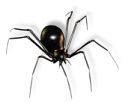|
 In cases of spider bite from a highly venomous spider, or if there is concern about a spider bite, the victim should be kept as quiet as possible - even walking should be kept to a minimum. Excitement or activity increases heartbeat and therefore circulation of the venom. A broad, firm bandage (not a tourniquet) may be applied over the wound on the heart side of the bite, especially if there is likely to be a delay in obtaining veterinary help. In the case of a Red-Back spider bite, keep the victim calm, preferably lying down, and seek veterinary attention as soon as possible.
Anti-venene is administered if the bite is definitely from a Red-back Spider and only then if the patient shows clinical signs of venom absorption.
As the fangs of the red-back spider are so small, the venom is placed just under the skin and the application of a firm bandage is not recommended.
An ice pack applied to the bitten area will help reduce the circulation at the bite site and also the associated pain. In case treatment is necessary, take the spider with you (in a jar), so that the
veterinary staff can determine the type of treatment required. In cases of spider bite from a highly venomous spider, or if there is concern about a spider bite, the victim should be kept as quiet as possible - even walking should be kept to a minimum. Excitement or activity increases heartbeat and therefore circulation of the venom. A broad, firm bandage (not a tourniquet) may be applied over the wound on the heart side of the bite, especially if there is likely to be a delay in obtaining veterinary help. In the case of a Red-Back spider bite, keep the victim calm, preferably lying down, and seek veterinary attention as soon as possible.
Anti-venene is administered if the bite is definitely from a Red-back Spider and only then if the patient shows clinical signs of venom absorption.
As the fangs of the red-back spider are so small, the venom is placed just under the skin and the application of a firm bandage is not recommended.
An ice pack applied to the bitten area will help reduce the circulation at the bite site and also the associated pain. In case treatment is necessary, take the spider with you (in a jar), so that the
veterinary staff can determine the type of treatment required.
All spider bites may cause pain and potential swelling and infection. The spiders to be concerned about however are the widow spiders - black widow noted by the red hourglass on her belly, the western black widow, brown widow of the south and the red widow common to Florida. Widow spiders inject a venom (Latrodectus venom ) that is a most potent biological toxin. The resultant painful cramping of all major muscles groups account for most of the clinical signs. Recovery may be prolonged with weakness and even partial paralysis persisting for several days.
Brown spiders, of which the most noted is the brown recluse, have a violin shaped marking on the cephalothorax. This mark may be indistinguishable or nonexistent in some species of brown spiders.
Within 4 to 8 hours a bulls eye look appears around the bite with the centre
appearing pale. This may degenerate into and ulcer that may enlarge and spread to underlying tissue. The final tissue damage may takes months to heal.
|